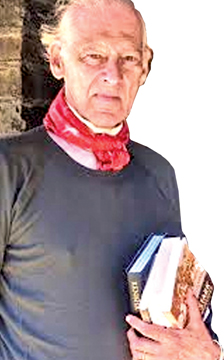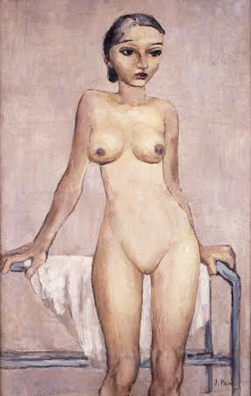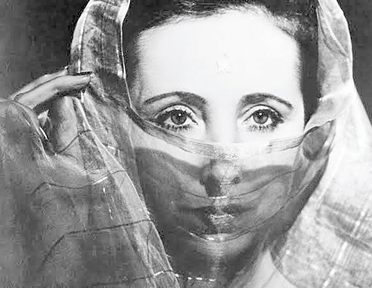|
Anais Nin - 1903 -1977:
Always searching for love
Of all the remarkable modern paintings I have collected, the one I
love the most is 'The Blue Nude' painted of Anais Nin in Paris by Justin
Daraniyagala in 1929. It is the only known existing portrait of the
feminist author who pioneered self-expression in the Western literary
world, and is an extraordinary painting that recalls Picasso's statement
that 'a painting is the sum of is destructions'.
 Anais
Nin was an author born to Cuban parents in France. She wrote journals,
which span over sixty years, beginning when she was eleven-years-old and
ending just before she died. Most of her work was published
posthumously. Anais
Nin was an author born to Cuban parents in France. She wrote journals,
which span over sixty years, beginning when she was eleven-years-old and
ending just before she died. Most of her work was published
posthumously.
Nin's father, Joaquin Nin, was a Cuban pianist and composer; her
mother, Rosa Culmell, a Cuban singer of French and Danish descent. After
her parents separated, her mother moved her and her two brothers, first
to Barcelona and then to New York City. She abandoned school when she
was sixteen-years-old and began working as an artist's model. When she
was twenty years old, she married her husband Hugh Parker Guiler - a
banker who later experimented with films. They moved to Paris in 1924
where she intensified her interest in journal writing.
Enormously popular
In these writings she discovered that her highly personal feelings
could be recorded in journals but could not be spoken openly. Guiler
continued his business interests, while his young wife underwent therapy
with Otto Rank - a psychiatrist who eventually became her lover. Rank
encouraged her to live a life that was true to herself.
Nin remained married to Guiler for the rest of her life, but in 1931
began an affair with the writer Henry Miller (Tropic of Cancer and
Tropic of Capricorn), who at the time was middle-aged, homeless and
unpublished. She on the other hand thought his profane writings to be
works of genius. For ten years she financed him while he wrote 'Tropic
of Cancer' - the book that eventually became enormously popular and
broke new ground in Western literature.
Many other young writers also flocked to Nin's door eager for
hand-outs. She was popular with her contemporaries but ignored as a
writer. Her work was regarded as a literary joke. She deceived her
long-suffering and tolerant husband with Henry Miller, then Miller with
her psychiatrist, as well as several of her friends. Finally Joaquin Nin,
her pianist father, came back into her life. In 'Incest', part of 'A
Journal of Love: The Unexpurgated Diary of Anais Nin' (1932-34) she
explains how, twenty years earlier, her father abandoned her and her
mother in New York. Then she gives details of how she seduced her
father. This was also the covert theme of her 'House of Incest' - a book
much admired in the 1940s by the American critic Edmund Wilson and by
Gore Vidal, the author of 'Palimpsest'.
Eventually at the outbreak of the Second World War in 1939, Miller
retreated to the safe shores of California, while Nin and her husband
returned to New York. There she embarked on her now legendary career
promoting the existence of her extraordinary diaries, which Miller, her
former lover, criticised as being a celebration of her life and loves.
 However,
back in 1928-29, before she met Henry Miller, Anais Nin, always
searching for love, and for a publisher of her diary, and forever short
of money, resorted to posing nude for a number of artists including
Matisse, Picasso and Justin Daraniyagala. In 'Artists and Models', an
excerpt from her much later erotic collection 'Delta of Venus', Nin
described the experience of posing: However,
back in 1928-29, before she met Henry Miller, Anais Nin, always
searching for love, and for a publisher of her diary, and forever short
of money, resorted to posing nude for a number of artists including
Matisse, Picasso and Justin Daraniyagala. In 'Artists and Models', an
excerpt from her much later erotic collection 'Delta of Venus', Nin
described the experience of posing:
Quite innocent
"One morning I was called to a studio where a sculptor was beginning
a statuette. He already had a rough version of the figure he wanted and
had reached the stage where he wanted a model. The statuette was wearing
a clinging dress, and the body showed through in every line and curve.
The sculptor asked me to undress completely because he could not work
otherwise. He seemed so absorbed by the statuette and looked at me so
absently that I was able to undress and take the pose without
hesitation. Although I was quite innocent at the time, he made me feel
as if my body was no different than my face, as if I were the same as
the statuette. Whenever I left the sculptor's studio I would always stop
in the coffee shop nearby and ponder on all that he had told me. I began
to love posing for the adventurous aspect of it."
Gore Vidal describes how he saw Nin in those early Paris days.
"Tweezed eyebrows in the twenties manner. Beautiful hazel eyes ... The
body was that of a dancer, very slender, with a long waist, small
breasts with pink nipples - like a girl." In return she called Vidal "a
nice little monster I have taken to my breast."
In Nin's early life she was an outcast - a woman who wrote about sex
from her own female point of view. She continued to be insistent that
her journals should be treated as a major work of literature. But they
weren't.
She was accused of narcissism, sociopathy, and sexual perversion.
Nevertheless her writings were brave in her time and she was the first
exponent of feminine feelings - hated by many, misunderstood by most,
and regarded as a flamboyant amateur tolerated only as a source of
funding thanks to her wealthy husband.
In 1947, when she was 44-years-old, Nin met actor Rupert Pole in an
elevator on the way to a party in New York. Pole was sixteen years
younger than she was. They struck up an immediate intimate relationship
and then travelled to the West Coast together.
Eight years later Nin, despite being still married to Guiler,
bigamously married Pole in Quartzsite, Arizona, and then settled down
with him in California. Guiler remained in New York, unaware of Nin's
Arizona marriage.
Not much later, in 1966, as both Guiler and Pole claimed Nin as a
dependent on their US tax returns, she had to have her marriage to Pole
annulled. However, she continued to live with Pole until her death in
1977. It was only then that Guiler found out about her second marriage.
But before that, when she was 63 years old, in 1966, her strange
self-promoted life suddenly made her into a star. It was the explosion
of the feminist movement of the sixties that gave Nin her literary
boost. Harcourt Brace published 'The Diary of Anais Nin' - a monumental
piece of writing that spanned fifty years and filled seven volumes. The
diaries not only contained details of her personal experiences with
literary and other friends, but also introspective passages about the
nature of her self. These were the works main attraction and sales were
extraordinary. Thus Anais Nin, in the 1960s, became the feminine icon -
worshipped by young women who saw Nin's work as an account of how a
woman could thrive in a male-dominated world of literature.
Literary fame
She toured the United States, reading from her journals, giving
lectures and promoting sales of her books. She harnessed herself to the
growing feminist movement. In 1973 she received an Honorary Doctorate
from the Philadelphia College of Art, and the following year was
presented with the 'Los Angeles Times Woman of the Year Award'.
 Anais
Nin died of cancer on 14 January 1977 at the height of her literary
fame. Her body was cremated and her ashes scattered over Mermaid Cove in
Santa Monica Bay. When her husband Hugh Guiler died in 1985m his ashes
too were scattered in Mermaid Cove. On Guiler's death Rupert Pole was
named Anais Nin's literary executor and it was he who arranged for four
new and unexpurgated editions of Nin's work to be published between 1985
and his eventual death in 2006: 'Henry and June', 'Fire', 'Incest', and
'Nearer the Moon'. Many portions of Nin's diaries are still unpublished
and can be seen only in the library of the University College of Los
Angeles. Anais
Nin died of cancer on 14 January 1977 at the height of her literary
fame. Her body was cremated and her ashes scattered over Mermaid Cove in
Santa Monica Bay. When her husband Hugh Guiler died in 1985m his ashes
too were scattered in Mermaid Cove. On Guiler's death Rupert Pole was
named Anais Nin's literary executor and it was he who arranged for four
new and unexpurgated editions of Nin's work to be published between 1985
and his eventual death in 2006: 'Henry and June', 'Fire', 'Incest', and
'Nearer the Moon'. Many portions of Nin's diaries are still unpublished
and can be seen only in the library of the University College of Los
Angeles.
Eighteen years after Anais Nin died a poisonous biography of the
author was published in 1995, written by Deirdre Blair. In it, she
delves into Nin's original diary and her now infamous erotic exploits
among the intellectual elite.
She classifies Nin as a distasteful narcissist and bigamist who was a
compulsive liar and whose obsessive diary keeping resulted not in
biography but in works of fiction that portrayed her pathological erotic
fantasies.
Although painstakingly researched, it is one of the deadliest
literary biographies in literary history. Blair describes Nin's attitude
as one of 'monstrous egotism and selfishness, horrifying in its callous
indifference.' Every dirty secret of Nin's personal life seems to be
exposed and it almost seems as if the author is bent on demolishing
Nin's literary reputation.
However, far from destroying Nin's legend, Blair's biography has
elevated Nin's position in the annals of literary erotica. Sales of her
books have multiplied and she is now regarded as being the solitary
pioneer who broke the boundaries of sexual literature.
More than that Anais Nin is now regarded as one of the leading female
writers of the 20th century and a source of inspiration for women
challenging conventional defined gender roles. No less than fifteen
volumes of Nin's journals have now been published and she continues to
be renowned in the literary world as the first to explore the sensitive
world of feminine self-discovery.
(The 'Literary Lives' series was originally
featured in Sri Lankan Anchorman, Toronto, Canada) |

